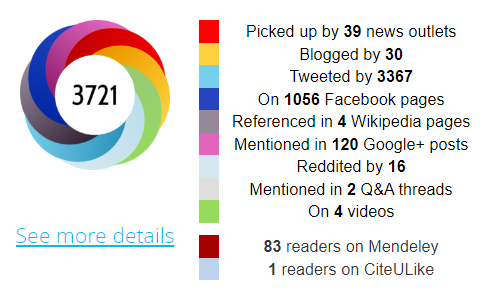Easy tips for promoting your work.
Self-promotion can be a daunting and time-consuming task. With 5 to 7 million journal articles published each year, it is increasingly necessary to bring attention to your work rather than relying solely on publication as the end goal. Here are some tips to streamline the promotion process and help you get the most out of your time.
In this article, we will cover:
- Where to start
- What to do before, during, and after publication
- How to assess the impact of your promotional efforts

Where to start
It’s time to become discoverable. When people read one of your publications they may want to find out more. Making that process easy for them will help them to engage with your work in general, and give them a better idea of the kind of work you’re looking to take part in.
Let’s go through the process step-by-step, from the easiest and most important steps to the more difficult and niche ones.
Step 1: Keep your institutional profile up to date
If you work for a university or research organization, they likely have a profile page about you. This online profile is the first place people will look for information about you and your work. Reach out to the communications or web team at your organization. Work with them to ensure that your profile is up to date and paints a clear picture of your research.
The information on this page doesn’t have to be wholly specific to your work. Explain the broader context of your field, why it's important, and where your work fits into the bigger picture. You want this page to answer the following questions:
- What are your areas of expertise?
- How does your work fit into the field you’re in?
- What projects are you currently working on?
- What are you interested in working on in the future?
Step 2: Develop your online identity
It’s now time to set up some searchable profiles. The most used, and therefore most important, academic profiles to have are ORCID, Google Scholar, and Scopus Author ID. These services make it easier for people searching for your research to focus specifically on you and your work, rather than sifting through articles by authors with similar names or research areas.
Make it even easier for people to see your publishing history by adding a link to each of these profiles on your institutional profile and adding them to your email signature.

Find out more about them here:
Step 3: Make your work accessible
Get into the habit of making all of your work accessible, not just your published articles. Research management tools like ResearchGate, Academia.edu, and Mendeley will help the general public, students, and other academics to engage with your work, and save it for later. Go through your publication history and ensure that all your work is available on those platforms. This might take some time, but it’s well worth the effort.
Many of the activities you participate in as a researcher can, and should, be shared. This includes your datasets, conference submissions and presentations, and peer reviewing. These aspects of academic life have previously been difficult to reference, but there are large online repositories that cater to them and ensure they’re accessible.
Where to share:
- Publications: Mendeley, ResearchGate, Academia.edu, Zotero
- Data: Figshare
- Presentations: SlideShare
- Peer Review: Publons
Step 4: Engage with social media
Social media can be a helpful networking tool, but it’s not a requirement. For some people it is an excellent way of staying connected to others in their field, hearing about new publications, or forming connections with future collaborators. For others, it’s a time sink full of distractions. If you would like to try your hand at social media, we recommend starting with LinkedIn and/or Twitter.
LinkedIn can be treated much the same as your institutional profile. It has your educational and professional background, some publications, and general information about you.
You could even reuse the content that already exists on your institutional profile to fill out the blurbs about yourself. From there you connect with people you know, and share updates about your work.

Twitter is less about you, and more about who you connect with. Ensure your profile is filled out with a profile picture and description and then search for people in your field who you’d like to get updates from. Fine-tuning your Twitter experience takes time, but if you pay attention to the profiles that you find interesting you’ll eventually find your way into niche communities related to your specific interests. Share your work here. Retweet other people’s work. Use your Twitter account as a space to share ideas, publicize events, and engage with your peers.
Social media is social. It works better when you take part and engage with the information others are sharing. The more engaged you are with the communities you’re part of, the more you’ll get out of it. But remember, this is also a professional profile. What you post and how you respond to people will be seen as an extension of your professional life.
Step 5: Build your own audience
If you want to put in the extra time and energy, you can start building your own audience by creating a space on the internet specifically about you and your work. This could be a website, newsletter, podcast, youtube channel, TikTok account - you name it!
When building your own audience, it pays to focus on consistency. Create a schedule that is manageable for you, and stick to it. Once you’ve decided on a content channel, and a schedule, it’s time to decide what you want to create content about. There are two main routes here: share specialized information, or establish yourself as an expert in the wider body of research.
There are no wrong answers. Specializing ensures a small audience of people interested in your specific niche while creating content about your wider field will attract a larger and more general audience. The important part is to know who you want to reach, to focus on them, and to stay consistent.

What to do before, during, and after publication
You’ve established your online presence, you’ve made your work accessible, and now it’s time to develop your ongoing promotional process.
Before publishing
When you begin a piece of research, set aside some time to consider the possible audiences for the work. Do you want a general audience to engage with it or a highly specialized audience? What kinds of questions would that audience ask about this topic? What new information can you present to them to grab their attention?
As you continue your research, set aside notes and insights that might be useful to publicize later. Highlight parts of your grant applications or emails to colleagues that you think make interesting points. Decide on keywords and phrases for this project and reuse them across multiple mediums for consistency. Your keywords should define what your content is about, boiling it down into short sentences. Consistent messaging is key. It’ll save you time and keep your promotional materials on-topic.
Consider imagery that might help to bolster your messaging, and set aside any images from your research that might be visually appealing to your audience. A nice image will capture attention much faster than a sentence. Seek out opportunities to create effective images.
If you’re comfortable talking about your work before it’s done, share insights into how the project is going through the content channels above.
During Publishing
Publication is a long process, but there is a lot of promotional work you can do ahead of the publication date to get momentum going.
Firstly, write up a clear draft of your article. Read through our ‘How to write a scientific paper’ blog for tips. Pay particular attention to the title and abstract of the article. Search engines and databases will present the title and abstract to their users, usually without the context of the rest of the article, so you can’t rely on any other part of the article to grab a reader’s attention.
Consider using a preprint service. If you’re unfamiliar with them, a preprint is a full draft of your paper published before it is peer-reviewed.

Publishing and circulating your preprint gives you an opportunity to get feedback and critique from your peers ahead of submitting to a traditional journal, potentially strengthening your work and demonstrating interest in the work. Your preprint will have its own DOI - which is often included in the later publication - so that it can be referenced separately from the eventual publication.
Go with an open-access journal if you can. More journals are turning toward open-access as a publication option, and while it is an added expense it also increases the likelihood of your work being seen, used, and cited by others.
Once your article has been accepted for publication, start engaging with the communications experts around you. Work directly with the marketing team for the journal you’re publishing in. Make yourself available to take part in an interview, or just have a discussion with them about the work and why it’s important. Ask them if there are any restrictions around promoting your work that you, or the team at your institution, need to be aware of.
Contact the communications team or research office at your institution. Give them advanced warning of the publication coming out, a plain English summary of the work, and a link to the preprint if it’s available. Share your keywords, phrases, and images with both the journal and your institutional team. This will ensure that all of the information coming out about your work has consistent visuals and messaging.
Engage directly with organizations that reach your audience. This could include giving a talk for a funding body, or applying to present at a conference. Ask yourself, and your colleagues, where your audience is and which groups already have access to them.
Related: How to write a scientific paper for publication »
After Publishing
Once your article is published and any embargoes lifted, you’ll be able to spread the word. The journal, and the communications team at your institution, will be publishing promotional material. Send that material around. Retweet it. Link to it on LinkedIn. Add it to your website. Include it on your institutional profile. Add a link to it in your email signature. Send it to your colleagues. Speak about it at conferences.
You’ve put in the work ahead of time, so this process should be straightforward. You already have your keywords and phrases. You’ve collected useful images from the research process. And you’ve established an online presence that allows you to share this information. So, share it wherever you can and make sure it is as widely accessible as possible.
Related: Connecting with clinicians: Tips for translating your research to clinical practice »
How to assess the impact of your promotional efforts
When dealing strictly with publication, the impact can be quantified by the number of times your work is cited, the journal impact factor, and your overall h-index. For wider promotion, altmetrics are a useful evaluation tool. As the name suggests these are alternative metrics, providing information about the places your research is being linked, cited, and talked about. This can help you keep track of who is paying attention, and if your work is being represented accurately in the public sphere.
As you continue to build your style of self-promotion, altmetrics can guide you toward the best places to focus your efforts. A good promotional strategy can take 12-18 months to mature, so don’t expect to go viral during your first promotion. Stay consistent, stay accessible, and keep an eye on the places your work flourishes.
Find altmetrics here:

Helpful Resources
- Annesley, Thomas M. “The Abstract and the Elevator Talk: A Tale of Two Summaries.” Clinical Chemistry, vol. 56, no. 4, Oxford UP (OUP), Apr. 2010, pp. 521–24. https://doi.org/10.1373/clinchem.2009.142026.
- Bik, Holly M., et al. “Ten Simple Rules for Effective Online Outreach.” PLOS Computational Biology, edited by Philip E. Bourne, vol. 11, no. 4, Public Library of Science (PLoS), Apr. 2015, p. e1003906. https://doi.org/10.1371/journal.pcbi.1003906.
- Bourne, Philip E. “Ten Simple Rules for Getting Ahead as a Computational Biologist in Academia.” PLoS Computational Biology, vol. 7, no. 1, Public Library of Science (PLoS), Jan. 2011, p. e1002001. https://doi.org/10.1371/journal.pcbi.1002001.
- Hardman, Timothy C., et al. “Ten Tips for Promoting Your Research.” Cardiovascular Endocrinology & Metabolism, vol. 9, no. 1, Ovid Technologies (Wolters Kluwer Health), Mar. 2020, pp. 30–35. https://doi.org/10.1097/xce.0000000000000191.
- Norris, Michael, et al. “The Citation Advantage of Open-access Articles.” Journal of the American Society for Information Science and Technology, vol. 59, no. 12, Wiley, Oct. 2008, pp. 1963–72. https://doi.org/10.1002/asi.20898.
